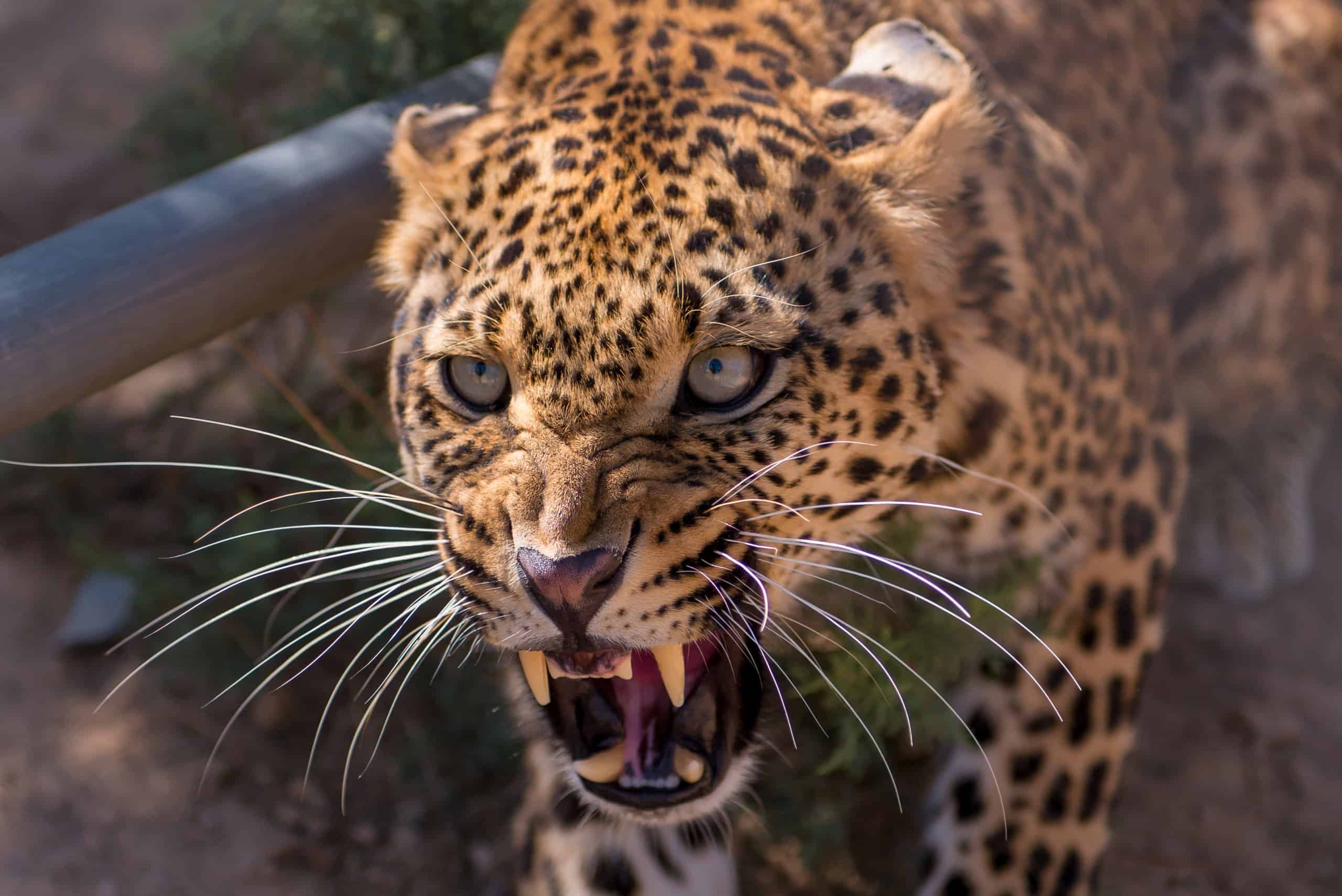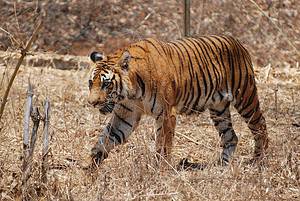Continue reading for our analysis...

Being a zookeeper or an animal specialist is a rewarding job. You get to spend time with wild animals that many people only get to see from a distance. One man who works with large cats knows just how special his work is to him.
In a video, you see all types of big cats relaxing in the sun as the gentleman talks to the camera. If you watch what’s going on in the background, you’ll eventually spot a leopard charging toward the man.
This is part of the job. Even though these animals and their keepers can be trained and educated, that doesn’t stop these cats from being wild. No matter how long an animal is in captivity, it’ll still have natural instincts.

The leopard is a solitary and nocturnal animal that hunts both on the ground and in the trees.
©Rudi Hulshof/Shutterstock.com
As the leopard makes his way toward the man, a protective tiger swoops in and saves the day. The two cats end up right by the keeper as he swats away the leopard’s powerful paw. Leopards stalk their prey from a few feet away, positioning themselves for an attack in case the prey moves in their direction.
Once the target comes within striking distance, it dispatches it in a single, quick, and vicious motion, usually by grasping the neck and snapping it. Smaller vertebrates, like rats, can complete the task with just one paw swipe.
The ability of the leopard to run at speeds of nearly 40 per hour gives it a distinct advantage when hunting. Beginning at the age of three to four months, hunting becomes more skilled practice for young leopards.
Big Cats, Small Environment

Tigers have highly textured tongues for rasping meat off bones.
©Thorsten Spoerlein/Shutterstock.com
One of the most recognizable large cats in the world is the tiger, about which we continue to learn more and more as time passes. Due to the variety of their habitats, tigers frequently come into contact with other big cats, such as leopards. However, are these cat predators just another kind of food for tigers?
Three different leopard species share territory with tigers. These include common leopards as well as the closely related clouded leopard and snow leopard species. Each species is considerably weaker and smaller than tigers, making them extremely susceptible to conflict with one another.
Leopards and tigers do occasionally engage in interspecies combat, but most of the time, they make sure to stay out of each other’s habitats. They may cross paths if food or mates are in short supply, but they will only attack if there aren’t enough sources of food for everyone.
In a fight between a leopard and a tiger, the tiger will nearly always emerge as the winner. Thankfully, this brawl didn’t get too intense, and everyone is safe and sound!
Is It Normal For a Tiger to Fight a Leopard?

A tiger is much larger and faster than a leopard, so it is a threat to a leopard.
©Ondrej Prosicky/Shutterstock.com
A tiger is a powerful hunter, and adult tigers have very few predators. Humans are the main predators of these cats. But they are also vulnerable to elephants and large buffalos due to the extraordinary strength and size of these mammals. These big cats’ speed, claws, and teeth are all defensive features that make the tiger an apex predator.
Because the leopard is a stealthy. and usually apex. predator throughout its natural environment, the biggest threat to adult leopards are other leopards, along with the occasional lion or tiger that can get close enough. Some tigers live in Southeast Asia, and so do some leopards, so there may be conflicts with the two animals sharing the same location.
So the answer to the question, “Is it normal for a tiger to fight a leopard?” is Yes. A tiger weighs 500- 660 pounds and can run at speeds up to 60 mph. A leopard weighs 60-200 pounds and has a top speed of 36 mph. If a leopard is smart, it will not engage with the tiger but stay up in a tree scouting for its own prey and watching for danger. The tiger could make a meal out of the smaller leopard, so the leopard has to beware!
Other Amazing Videos You Might Like
The video starts with a large leopard pacing along a tree branch. And then a baboon of impressive size bounds into view and swipes at its adversary. At this point, the leopard slips and grasps the branch desperately.
Triumphant, the enraged primate swipes at the wild cat, which clings on for dear life, attempting to swing its hind legs upwards in order to support the weight exerted on its forelimbs. But to no avail. At last, gravity and, quite possibly, fright and panic gain the upper hand, and the feline plummets a considerable distance to the ground. But far from crashing in an injured heap, the cat springs to its feet and dashes towards the dense brush where its foe has no chance of spotting it.
Click Below to See The Full Video:
How Large Are Adult Tigers?
It depends on the type of tiger. However, in general, a tiger’s body measures 5 to 10.5 feet long and can weigh from 240 to 675 pounds. For example, a 6-foot tiger is equal in length to a full-size bed. If it weighs 500 pounds, it is half the weight of a grand piano!
The largest tiger ever weighed more than 800 pounds. The largest subspecies of tiger is the Siberian, which has an average weight that reaches up to 675 pounds!

The Siberian tigers, or Amur tigers, are gorgeous creatures and the biggest of all tigers.
©iStock.com/Byrdyak
As to other measurements, this cat’s striped tail measures about three feet long. This is equal to the length of three wooden rulers lined up end to end. The tiger’s claws are four inches long and are used to grab onto prey.
Thank you for reading! Have some feedback for us? Contact the AZ Animals editorial team.







